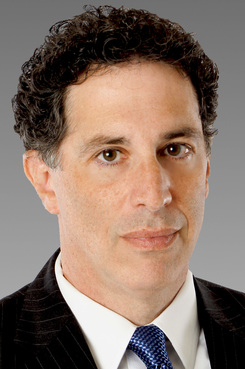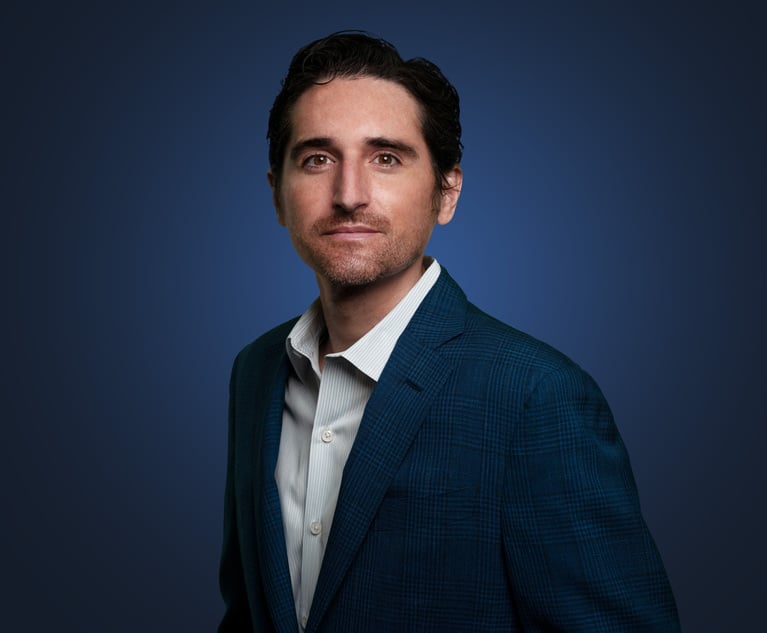From Rocket Boots to Fusion Reactors: Patents Show Us Our Future
Would you like to see the future of technology? You can. When patents (and patent applications) are published, the public is given an opportunity to see the latest ideas that are currently in development.
December 21, 2018 at 04:19 PM
6 minute read
 Lawrence Ashery.
Lawrence Ashery.
Would you like to see the future of technology? You can. When patents (and patent applications) are published, the public is given an opportunity to see the latest ideas that are currently in development. While many patents are not based on actual products, some are. This is why futurists study the databases of the U.S. Patent and Trademark Office (USPTO): to learn more about the technology that will one day shape our lives. Here are some of the patents (and patent applications) that were published in 2018, and that offer a glimpse into what our world will look like in the near future.
- Physical and Emotional Analysis (U.S. Patent 10,096,319)
Today when you speak to your virtual assistant (such as Echo and Alexa), a computer listens to your instructions and commands and responds accordingly. But what if the virtual assistant had the ability to evaluate your physical or emotional well-being? Amazon is working on the technology to make this happen. According to an Amazon patent, it is possible to design a virtual assistant that can listen to your voice and evaluate your well-being. Cough while speaking to your virtual assistant, and you may be offered one-hour delivery of cough drops or a recipe for chicken soup. Speak with a tone of voice that indicates you are bored, and the technology may suggest that you be entertained with a movie.
- Junk Call Filter (U.S. Application 2018/0295140)
If you are tired of receiving unwanted sales calls on your mobile phone, Apple might have a solution for you. Unsolicited calls are often received with a caller ID that makes it appear the call originated from a local number. Apple has invented a method of looking at data fields associated with an incoming phone call to obtain more information. The retrieved data can then be compared with a database to determine whether the incoming phone call is indeed desired by the recipient. In this manner, unwanted calls can be rejected so that the phone's owner is not disturbed.
- Rocket Boots (U.S. Application 2018/0127094)
Personal travel continues to become more technologically innovative, but one company claims they have designed an apparatus that provides a new level of personal mobility. A pair of boots attached to a passenger's feet allows the passenger to travel in the air to a desired destination. Each boot includes turbojet engines for enabling both vertical and horizontal motion. Sensors in each boot detect foot pressure that is used to specify direction of travel. A tank stores fuel that is used to power each turbojet.
- Flexible Displays (U.S. 10,104,787)
Flexible visual displays have actually been in development for years, and display technology is becoming more and more advanced. Manufacturers have been making steady progress in commercializing this technology, and it is expected that products with foldable displays will be available for consumer purchase within the next few months. Samsung, for example, recently demonstrated a folding smartphone at a developer conference. In the meantime, companies continue to file patent applications directed toward these products. Apple, for example, recently obtained a patent in which a foldable display includes detents, so that once the display is bent into position, the display stays in that position. A screen bent into an inverted “V” configuration allows two people sitting opposite each other to view their own respective portion of the display. This feature allows two users to watch two different movies simultaneously.
- Smart Shopping Carts (U.S. Application 2018/0240554)
Navigating a large store with a shopping cart can be very challenging, but Walmart has developed technology to improve the experience. A shopping cart includes sensors in its handle to measure a shopper's biometrics. For example, the sensors can monitor a shopper's heart rate, body temperature and force against the handle. In addition, the sensors allow monitoring of the speed at which the shopper is pushing the cart through the store. The data from the sensors can indicate if the shopper is experiencing anxiety or a potentially dangerous medical condition. An alarm signal can be transmitted to a central location to advise of a potential problem, along with the location of the shopping cart. A store employee can then approach the customer and ask whether any type of assistance is needed.
- U.S. Patent 10,000,000
The 10 millionth U.S. patent certainly relates to cutting-edge technology, but what is more astonishing is the fact that the U.S. patent and trademark office has issued 10 million patents in its history. The ten millionth U.S. patent relates to LADAR, a technology similar to radar that uses lasers to measure object distance. The patent issued on June 19, 2018, and the USPTO conducted a ceremony to commemorate the historic events. At that time, Commissioner for Patents Drew Hirshfeld stated: “The U.S. patent system serves as a reminder that our nation values and continues to be built by those who are willing to take risks, challenge traditions, push the boundaries of convention and test new limits in design and thought.”
- Block Chain (U.S. Application 2018/0240112)
Cryptocurrencies such as bitcoin have been prominently featured in the news over the past year, mostly because of large value fluctuations. This technology, however, has attracted significant interest from the financial industry due to its robustness and flexibility. As a result, many financial institutions have been developing and attempting to patent blockchain processes. For example, Bank of America has filed a patent application for a blockchain system that encrypts data elements using an encryption key and that embeds the encrypted data elements into a blockchain.
- Fusion Reactor (U.S. Application 2018/0047462)
Fusion power is in early stages of development and is believed to be a significant source of energy in the future. While large quantities of funding have been devoted to fusion power research, commercializing the technology has not yet been possible. Lockheed Martin, however, has been developing a possibly world changing fusion reactor, and it has filed many patent applications related to various advancements. In particular, large amounts of plasma are generated at a temperature much higher than can be held in any physical container. Thus, the plasma is contained in magnetic fields. Lockheed Martin's patent application relates to a fusion power device that is small enough to be mounted on a vehicle such as a truck, aircraft, ship, train, spacecraft or submarine.
Lawrence E. Ashery is a partner in the Philadelphia office of Caesar Rivise. He focuses his practice on all aspects of intellectual property law. He can be reached at [email protected].
This content has been archived. It is available through our partners, LexisNexis® and Bloomberg Law.
To view this content, please continue to their sites.
Not a Lexis Subscriber?
Subscribe Now
Not a Bloomberg Law Subscriber?
Subscribe Now
NOT FOR REPRINT
© 2025 ALM Global, LLC, All Rights Reserved. Request academic re-use from www.copyright.com. All other uses, submit a request to [email protected]. For more information visit Asset & Logo Licensing.
You Might Like
View All
AI and Social Media Fakes: Are You Protecting Your Brand?

Neighboring States Have Either Passed or Proposed Climate Superfund Laws—Is Pennsylvania Next?
7 minute read
Seven Rules of the Road for Managing Referrals To/From Other Attorneys, Part 2
6 minute readTrending Stories
Who Got The Work
J. Brugh Lower of Gibbons has entered an appearance for industrial equipment supplier Devco Corporation in a pending trademark infringement lawsuit. The suit, accusing the defendant of selling knock-off Graco products, was filed Dec. 18 in New Jersey District Court by Rivkin Radler on behalf of Graco Inc. and Graco Minnesota. The case, assigned to U.S. District Judge Zahid N. Quraishi, is 3:24-cv-11294, Graco Inc. et al v. Devco Corporation.
Who Got The Work
Rebecca Maller-Stein and Kent A. Yalowitz of Arnold & Porter Kaye Scholer have entered their appearances for Hanaco Venture Capital and its executives, Lior Prosor and David Frankel, in a pending securities lawsuit. The action, filed on Dec. 24 in New York Southern District Court by Zell, Aron & Co. on behalf of Goldeneye Advisors, accuses the defendants of negligently and fraudulently managing the plaintiff's $1 million investment. The case, assigned to U.S. District Judge Vernon S. Broderick, is 1:24-cv-09918, Goldeneye Advisors, LLC v. Hanaco Venture Capital, Ltd. et al.
Who Got The Work
Attorneys from A&O Shearman has stepped in as defense counsel for Toronto-Dominion Bank and other defendants in a pending securities class action. The suit, filed Dec. 11 in New York Southern District Court by Bleichmar Fonti & Auld, accuses the defendants of concealing the bank's 'pervasive' deficiencies in regards to its compliance with the Bank Secrecy Act and the quality of its anti-money laundering controls. The case, assigned to U.S. District Judge Arun Subramanian, is 1:24-cv-09445, Gonzalez v. The Toronto-Dominion Bank et al.
Who Got The Work
Crown Castle International, a Pennsylvania company providing shared communications infrastructure, has turned to Luke D. Wolf of Gordon Rees Scully Mansukhani to fend off a pending breach-of-contract lawsuit. The court action, filed Nov. 25 in Michigan Eastern District Court by Hooper Hathaway PC on behalf of The Town Residences LLC, accuses Crown Castle of failing to transfer approximately $30,000 in utility payments from T-Mobile in breach of a roof-top lease and assignment agreement. The case, assigned to U.S. District Judge Susan K. Declercq, is 2:24-cv-13131, The Town Residences LLC v. T-Mobile US, Inc. et al.
Who Got The Work
Wilfred P. Coronato and Daniel M. Schwartz of McCarter & English have stepped in as defense counsel to Electrolux Home Products Inc. in a pending product liability lawsuit. The court action, filed Nov. 26 in New York Eastern District Court by Poulos Lopiccolo PC and Nagel Rice LLP on behalf of David Stern, alleges that the defendant's refrigerators’ drawers and shelving repeatedly break and fall apart within months after purchase. The case, assigned to U.S. District Judge Joan M. Azrack, is 2:24-cv-08204, Stern v. Electrolux Home Products, Inc.
Featured Firms
Law Offices of Gary Martin Hays & Associates, P.C.
(470) 294-1674
Law Offices of Mark E. Salomone
(857) 444-6468
Smith & Hassler
(713) 739-1250






